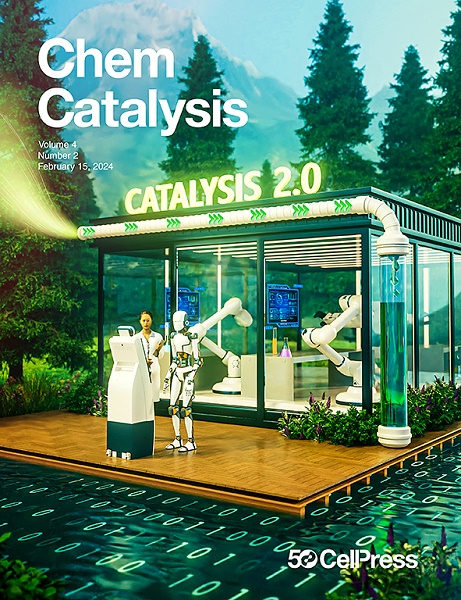通过活性位点、底物结构和动力学揭示α-酮戊二酸在Pd上的加氢作用
IF 11.6
Q1 CHEMISTRY, PHYSICAL
引用次数: 0
摘要
α-酮戊二酸(α-KGA)是生物基工业中一个即将出现的平台分子,目前正在探索催化增值策略。本研究在间歇式反应器中利用氢气研究了α-KGA的水相加氢反应,重点研究了催化剂性质、底物结构和动力学对催化活性的影响。5% Pd/C是最合适的催化剂(在40°C和50 bar条件下),具有较高的转换频率(4.3-7.9 s−1),而其他金属(Pt, Rh, Ru, Ni, Cu和Mo)则较差。主要产物α-羟基戊二酸收率高(95%),γ-羧基丁内酯收率低(3%)。此外,底物中的α-COOH基团增强了Pd的活性,而抑制了亲氧性Ru的活性。最后,钯表面α-KGA加氢两步法是最可行的表面反应途径。这些发现为α-酮酸活化的水相加氢提供了一个全面的认识,这对其他生物质衍生的含氧化合物是有用的。本文章由计算机程序翻译,如有差异,请以英文原文为准。

Unraveling the hydrogenation of α-ketoglutaric acid on Pd through active sites, substrate structure, and kinetics
α-Ketoglutaric acid (α-KGA) is an upcoming platform molecule in bio-based industries, with catalytic valorization strategies currently being explored. This study investigates the aqueous-phase hydrogenation of α-KGA using hydrogen gas in a batch reactor, focusing on the role of catalyst properties, substrate structure, and kinetics that affect catalytic activity. 5% Pd/C was the most suitable catalyst (at 40°C and 50 bar) with high turnover frequencies (4.3–7.9 s−1), while other metals (Pt, Rh, Ru, Ni, Cu, and Mo) were inferior. The main product, α-hydroxyglutaric acid, was typically produced in high yield (95%), with minor formation of γ-carboxyl butyrolactone (3%). Furthermore, the α-COOH group in the substrate enhanced the activity on Pd whereas inhibition occurred on oxophilic Ru. Finally, a two-step addition of hydrogen to α-KGA on Pd emerged as the most plausible surface reaction pathway. These findings provide a thorough understanding of aqueous-phase hydrogenation of activated α-ketoacids, which is useful for other biomass-derived oxygenates.
求助全文
通过发布文献求助,成功后即可免费获取论文全文。
去求助
来源期刊
CiteScore
10.50
自引率
6.40%
发文量
0
期刊介绍:
Chem Catalysis is a monthly journal that publishes innovative research on fundamental and applied catalysis, providing a platform for researchers across chemistry, chemical engineering, and related fields. It serves as a premier resource for scientists and engineers in academia and industry, covering heterogeneous, homogeneous, and biocatalysis. Emphasizing transformative methods and technologies, the journal aims to advance understanding, introduce novel catalysts, and connect fundamental insights to real-world applications for societal benefit.

 求助内容:
求助内容: 应助结果提醒方式:
应助结果提醒方式:


